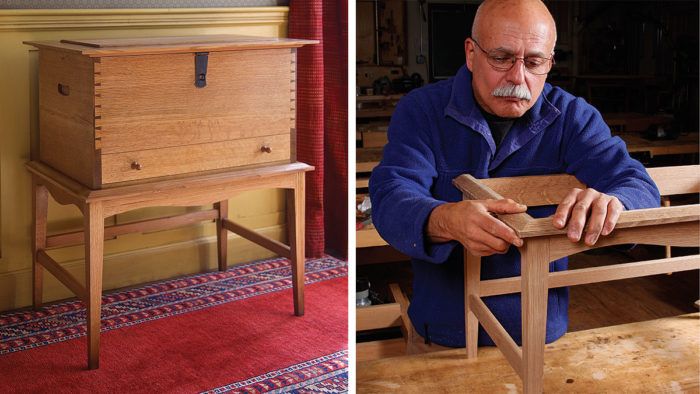Oak Chest on Stand
Design details evoke vintage English Arts and Crafts
Synopsis: This oak chest-on-stand is an homage to C.F.A. Voysey, a major influence in the English Arts and Crafts Movement. Mario Rodriguez designed the chest with half-blind dovetails, a single drawer, and a frame-and-panel lid where the panel sits proud of the frame. The base has tapered legs and a shop-made ogee molding that cradles the chest.
I’ve always been attracted to English Arts and Crafts furniture, in particular to the pieces designed by C.F.A. Voysey. Regarded as a major influence in early 20th-century design, Voysey designed pieces that embraced the ideas of the Arts and Crafts movement in England. His spare and timeless furniture is characterized by a wonderful sense of proportion, clean lines, and strong vertical elements that were often relieved by gentle horizontal curves.
To channel Voysey’s spirit, I built an English-inspired piece of furniture: a chest on stand in white oak. The chest itself has half-blind dovetails, a single drawer, and a frame-and-panel lid where the panel sits proud of the frame. The base has tapered legs and a shopmade ogee molding that cradles the chest.
Start with the chest

The case is joined with half-blind dovetails and has two compartments—the box up top and a drawer pocket below—separated by a horizontal divider. There’s also a rail below the drawer front. I cut the dovetails first, then I cut the grooves for the divider and chest bottom. Finally, I routed the mortises for the rail.
Dovetails first— I chose half-blinds instead of through-dovetails. Besides being aesthetically pleasing and strong, they allowed me to thicken the sides of the case to allow for the routed handholds.
I hand-cut the tail boards first, at 10°, and then laid them over the pin boards to transfer the dovetail outline. When the pins were marked out, I used a router to carefully remove the bulk of the waste. Once the pins were roughed out with the router, I then pared them back to the line with a chisel and tested the fit.
Grooves next— With the dovetails done and the case sides fitted, it’s time to take care of the chest’s internal parts. The grooves for the horizontal divider fall in the center of a tail, so they can be cut right-through using a dado set on the tablesaw. The grooves for the case bottom are stopped before reaching the front edge. I cut those with a router and clamped-on fence. Mortises for the rail—The front rail has integral tenons on the ends. The mortises for them intersect at their top end with the groove for the case bottom. At the bottom end, the mortises carry through the bottom of the case side. The rail’s top edge is rabbeted to receive the front edge of the case bottom. With this joinery cut, you can rout the handholds in the case sides.
For the full article, download the PDF below:
Fine Woodworking Recommended Products

Compass


Drafting Tools























Log in or create an account to post a comment.
Sign up Log in